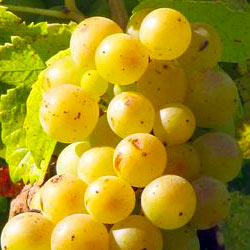I’m not sure why I’m such a pedantic twit when it comes to wine grape names. I suppose it’s because all European grapes have a name that typically means something whether it’s the place they’re from (like Carignan/Carinyena) or describes their history appearance or taste like Plavac Mali or Escanyavella (“little blue” and “old lady strangler”, respectively.) The problem is that in this digital day and age, if these things are wrong, then it seems to me like history is being betrayed a little.
Picapoll/Piquepoul
 My grape name bitchery starts with Picapoll or as it’s possibly known in English via the “French” name, Piquepoul. For those who don’t know it, this is a popular white varietal that also had red and grey versions as well. Light and easy to drink, it’s popular in both Catalonia as well as across the border in Southern France. The name is curious and is often cited as meaning “lip stinger” deemed to be due to the high acidity of the grape. I can only assume that this was derived from what was thought to be an originally French name, but I can’t understand how anyone arrived at this. I’m not fluent in French but I know people who are (and it’s a language that Google Translate is decent at) and while “piquer” is indeed the verb “to sting”, “poul” is a hen. This “lip stinger” was originally mentioned in a book from Jancis Robinson called “Vines, Grapes & Wines” originally printed in 1986 and reprinted until 1996 with the same mention that others then picked up on and quoted. Curiously, in her massive tome “Wine Grapes” printed in late-2013, I don’t see this mentioned again.
My grape name bitchery starts with Picapoll or as it’s possibly known in English via the “French” name, Piquepoul. For those who don’t know it, this is a popular white varietal that also had red and grey versions as well. Light and easy to drink, it’s popular in both Catalonia as well as across the border in Southern France. The name is curious and is often cited as meaning “lip stinger” deemed to be due to the high acidity of the grape. I can only assume that this was derived from what was thought to be an originally French name, but I can’t understand how anyone arrived at this. I’m not fluent in French but I know people who are (and it’s a language that Google Translate is decent at) and while “piquer” is indeed the verb “to sting”, “poul” is a hen. This “lip stinger” was originally mentioned in a book from Jancis Robinson called “Vines, Grapes & Wines” originally printed in 1986 and reprinted until 1996 with the same mention that others then picked up on and quoted. Curiously, in her massive tome “Wine Grapes” printed in late-2013, I don’t see this mentioned again.
I am of a mind that this is all wrong and maybe it’s better to look at the Catalan name, Picapoll. Given that this grape is thought to be from the south of France (although it’s still possible it’s from Catalonia) one should know that in Roussillon (Catalunya Nord) they originally spoke Catalan and those who didn’t spoke Occitan which is very, very closely related to Catalan (more so than Catalan to Castilian actually.) If you break down this word from the vantage of this language, you might still think that “pica” comes from the verb “picar” which again means “to sting” but let’s forget about that for a moment and take in to account that “picat” or “picada” are adjectives meaning “chopped”. Then look at “poll” which could mean “flea” or louse”. It seems like we’re no further in breaking this down from French except for one thing in that in Catalan “pell” means “skin”. It’s very believable that “pell” would become “poll” over centuries of use by peasants and so you actually have a name that means “chopped skin” which when you look at the grape is exactly what you see and you originally have “picadapell” for the original name. It all makes a great deal more sense than a “stinging hen” or well, whatever you get from the French name.
By no means am I saying that my relatively studied ability of Catalan mixed with my nearly non-existent ability with French are the end-all be-all to solving the mystery of this grape name, but it’s the fact that I think looking at it as a French-named grape is completely wrong, especially as “piquepoul” just sounds like a francofication of the original Catalan/Occitan name. Drink for thought though and something to keep in mind when encountering other “facts” in the world of wine.

molt xulo aquest escrit Miquel!!!
Try Occitan, this will explain where the name comes from, not modern French or Catalan.